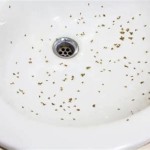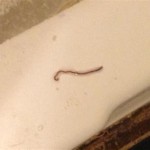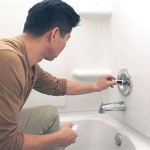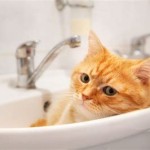How To Get Rid Of The Urine Smell In The Bathroom
The persistent odor of urine in a bathroom can be a frustrating and embarrassing problem. It can cling to various surfaces, permeate grout, and linger in the air, creating an unpleasant environment. Understanding the sources of this odor and implementing a systematic cleaning approach is crucial for effective elimination. This article will outline various methods to identify the source and eradicate urine smells effectively.
Identifying the Source of the Odor
Before beginning any cleaning process, locating the origin of the urine smell is paramount. A general cleaning of the bathroom may mask the odor temporarily, but it will likely return if the source is not addressed directly. Often, the smell originates from areas that are not immediately obvious. The following are common culprits:
Toilet and Surrounding Areas: The most obvious source is the toilet itself. Urine can splash or drip onto the floor around the base of the toilet, particularly behind it, where it can be difficult to see and clean. Check the toilet seat hinges, the tank, and the exterior of the bowl for any signs of urine residue.
Grout Lines: Grout is porous and readily absorbs liquids, including urine. Over time, urine absorbed into the grout lines surrounding the toilet or in other areas of the bathroom can become a significant source of lingering odor. The grout can appear discolored or stained.
Flooring: Depending on the type of flooring, urine can seep into cracks, seams, or porous surfaces. Vinyl flooring can develop tears or gaps over time, allowing urine to penetrate the subfloor. Similarly, porous tile can absorb urine if the grout is compromised.
Baseboards: Urine splashes can reach the baseboards, especially if children or pets are present. Inspect the baseboards near the toilet and other areas where urine may have splashed.
Walls: While less common, urine can occasionally splash onto the walls, particularly near the toilet or in smaller bathrooms. Check the lower portions of the walls for any signs of staining or residue.
Bath Mats and Rugs: Bath mats and rugs can absorb urine, especially if placed near the toilet. Even small amounts of urine can accumulate over time and contribute to a persistent odor. Regular washing is essential.
Toiletries and Storage Containers: Items stored near the toilet, such as wastebaskets, cleaning supplies, or storage containers, can sometimes become contaminated with urine. Ensure these items are clean and dry.
Once the likely sources have been identified, a targeted cleaning approach can be implemented. Using a UV flashlight in a darkened bathroom can help pinpoint areas where urine is present, as urine often fluoresces under ultraviolet light. This can be a valuable tool for locating hidden stains.
Effective Cleaning Solutions and Techniques
After identifying the source of the urine smell, selecting the appropriate cleaning solutions and techniques is crucial for effective elimination. A variety of products and methods can be employed, depending on the surface being cleaned and the severity of the odor. The following are some recommended approaches:
Enzyme-Based Cleaners: Enzyme-based cleaners are specifically designed to break down the uric acid crystals that cause the urine smell. These cleaners contain enzymes that digest the organic matter in urine, effectively eliminating the odor rather than simply masking it. These cleaners are available in various forms, including sprays, powders, and liquids. When using an enzyme-based cleaner, it is important to follow the manufacturer's instructions carefully. Generally, the cleaner should be applied liberally to the affected area and allowed to dwell for a specified period, often several hours or overnight, to allow the enzymes to work effectively. Afterwards, the area should be thoroughly rinsed with water and allowed to air dry.
Baking Soda: Baking soda is a natural deodorizer that can absorb odors and help to neutralize urine smells. For carpets or rugs, sprinkle baking soda liberally over the affected area and allow it to sit for several hours or overnight. Then, vacuum up the baking soda. For hard surfaces, a paste of baking soda and water can be applied to stains and allowed to dry before being scrubbed and rinsed.
Vinegar: White vinegar is another natural cleaning agent that can help to neutralize urine odors. Vinegar's acidic properties help to break down the alkaline components of urine. To use vinegar, mix equal parts white vinegar and water in a spray bottle. Spray the solution onto the affected area and allow it to sit for several minutes before blotting it up with a clean cloth. For stubborn odors, the vinegar solution can be left to dwell for a longer period. Vinegar can be used on most surfaces, but it is important to test it in an inconspicuous area first to ensure it does not damage the material.
Hydrogen Peroxide: Hydrogen peroxide is a mild disinfectant and deodorizer that can be effective in removing urine stains and odors. A 3% solution of hydrogen peroxide can be sprayed onto the affected area and allowed to sit for several minutes before blotting it up with a clean cloth. For porous surfaces, such as grout, a paste of hydrogen peroxide and baking soda can be applied and allowed to dry before being scrubbed and rinsed. It is important to note that hydrogen peroxide can have a bleaching effect, so it should be tested in an inconspicuous area first, especially on colored or delicate materials.
Bleach: Bleach is a powerful disinfectant that can kill bacteria and eliminate odors, but it should be used with caution. Bleach can be corrosive and can damage certain materials. It should only be used on surfaces that are bleach-safe, such as ceramic tile or porcelain. When using bleach, it is important to wear gloves and protective eyewear and to ensure adequate ventilation. A diluted bleach solution (typically 1 part bleach to 10 parts water) can be applied to the affected area and allowed to sit for several minutes before being rinsed thoroughly with water. Mixing bleach with other cleaning agents, such as ammonia, can create toxic fumes and should be avoided.
Steam Cleaning: Steam cleaning can be an effective method for removing urine odors from carpets, rugs, and upholstery. The high temperature of the steam helps to kill bacteria and break down odor-causing molecules. Steam cleaners are available for rent or purchase. When using a steam cleaner, it is important to follow the manufacturer's instructions carefully. A detergent formulated for use with steam cleaners can be added to the water tank to enhance the cleaning power. After steam cleaning, allow the area to dry thoroughly to prevent mold growth.
Grout Cleaning and Sealing: Grout is particularly susceptible to absorbing urine, making it a common source of lingering odors. Thoroughly cleaning the grout lines is essential. A grout brush and a specialized grout cleaner can be used to scrub the grout lines. For stubborn stains, a paste of baking soda and hydrogen peroxide can be applied and allowed to dry before being scrubbed and rinsed. Once the grout is clean, sealing it with a grout sealer will help to prevent future absorption of liquids and odors. Grout sealers are available in various forms, including sprays and liquids. Follow the manufacturer's instructions for application. Reapplication of the grout sealer may be necessary periodically to maintain its effectiveness.
Preventative Measures and Ongoing Maintenance
Once the urine smell has been successfully eliminated, implementing preventative measures and establishing a regular cleaning routine is crucial to prevent its recurrence. Consistent maintenance can ensure a fresh and odor-free bathroom environment. The following are some recommended practices:
Regular Cleaning: Regular cleaning of the bathroom is essential for preventing the buildup of urine and other contaminants. The toilet, floor around the toilet, and other potentially affected areas should be cleaned at least once a week, or more frequently if needed. Use a disinfectant cleaner to sanitize surfaces and kill bacteria. Pay particular attention to areas that are prone to splashing or dripping.
Prompt Spill Cleanup: Any urine spills should be cleaned up immediately. The longer urine sits on a surface, the more likely it is to be absorbed and cause a lingering odor. Use an absorbent cloth or paper towels to blot up the spill, and then clean the area with an appropriate cleaning solution.
Bath Mat and Rug Maintenance: Bath mats and rugs should be washed regularly to remove any accumulated urine or other contaminants. Wash them according to the manufacturer's instructions, and ensure they are thoroughly dried before placing them back in the bathroom. Consider using washable bath mats for easy maintenance.
Ventilation: Proper ventilation is essential for preventing the buildup of moisture and odors in the bathroom. Ensure the bathroom is well-ventilated by opening a window or using the exhaust fan during and after showering or bathing. This will help to remove excess moisture and prevent the growth of mold and mildew, which can contribute to unpleasant odors.
Toilet Training Aids: For households with young children who are learning to use the toilet, consider using toilet training aids, such as splash guards or urinal mats, to minimize spills and splashes. These aids can help to contain urine and prevent it from spreading to other areas of the bathroom.
Pet Training and Hygiene: If pets are using the bathroom, ensure they are properly trained to urinate outside or in designated areas. Clean up any accidents immediately and thoroughly. Consider using pet-specific cleaning products that are designed to neutralize pet odors.
Toilet Maintenance: Regularly inspect the toilet for any leaks or cracks. A leaking toilet can contribute to moisture buildup and odor problems. Repair any leaks promptly and consider replacing older toilets that may be prone to problems. Ensure the toilet flapper seals properly to prevent water from continuously running, which can lead to mineral buildup and odors.
By following these preventative measures and maintaining a consistent cleaning routine, it is possible to keep the bathroom fresh, clean, and free of unpleasant urine odors. Regular maintenance is key to preventing the recurrence of this common household problem.

4 Ways To Get Rid Of Urine Smell Wikihow

The Complete Guide To Getting Rid Of Urine Smell In Bathroom

How To Get Rid Of Urine Smell In Bathroom Simple Effective Way Make You Clean

How To Get Rid Of Urine Smell In Your Bathroom

4 Ways To Get Rid Of Urine Smell Wikihow

How To Get Rid Of Urine Smell In A Bathroom Odorcide

6 No Fail Ways To Get Rid Of Smells In Bathroom Artsy Fartsy Life

4 Ways To Get Rid Of Urine Smell Wikihow

How To Remove Urine From Grout Around The Toilet

How To Remove Urine Smells From Toilets In 10 Minutes With 29p Kitchen Staple Express Co
Related Posts







